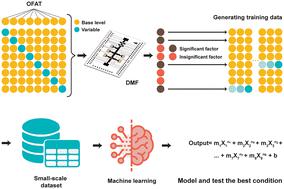Our official English website, www.x-mol.net, welcomes your feedback! (Note: you will need to create a separate account there.)
Integrating machine learning and digital microfluidics for screening experimental conditions
Lab on a Chip ( IF 6.1 ) Pub Date : 2022-11-23 , DOI: 10.1039/d2lc00764a Fatemeh Ahmadi 1, 2, 3 , Mohammad Simchi 4 , James M Perry 2 , Stephane Frenette 2 , Habib Benali 1, 2 , Jean-Paul Soucy 2, 5 , Gassan Massarweh 5 , Steve C C Shih 1, 2, 3
Lab on a Chip ( IF 6.1 ) Pub Date : 2022-11-23 , DOI: 10.1039/d2lc00764a Fatemeh Ahmadi 1, 2, 3 , Mohammad Simchi 4 , James M Perry 2 , Stephane Frenette 2 , Habib Benali 1, 2 , Jean-Paul Soucy 2, 5 , Gassan Massarweh 5 , Steve C C Shih 1, 2, 3
Affiliation

|
Digital microfluidics (DMF) has the signatures of an ideal liquid handling platform – as shown through almost two decades of automated biological and chemical assays. However, in the current state of DMF, we are still limited by the number of parallel biological or chemical assays that can be performed on DMF. Here, we report a new approach that leverages design-of-experiment and numerical methodologies to accelerate experimental optimization on DMF. The integration of the one-factor-at-a-time (OFAT) experimental technique with machine learning algorithms provides a set of recommended optimal conditions without the need to perform a large set of experiments. We applied our approach towards optimizing the radiochemistry synthesis yield given the large number of variables that affect the yield. We believe that this work is the first to combine such techniques which can be readily applied to any other assays that contain many parameters and levels on DMF.
中文翻译:

整合机器学习和数字微流体以筛选实验条件
数字微流体 (DMF) 具有理想液体处理平台的特征——近二十年的自动化生物和化学检测表明了这一点。然而,在 DMF 的当前状态下,我们仍然受到可对 DMF 进行的并行生物或化学测定数量的限制。在这里,我们报告了一种利用实验设计和数值方法来加速 DMF 实验优化的新方法。一次一个因素 (OFAT) 实验技术与机器学习算法的集成提供了一组推荐的最佳条件,而无需执行大量实验。鉴于影响产量的大量变量,我们应用我们的方法来优化放射化学合成产量。
更新日期:2022-11-23
中文翻译:

整合机器学习和数字微流体以筛选实验条件
数字微流体 (DMF) 具有理想液体处理平台的特征——近二十年的自动化生物和化学检测表明了这一点。然而,在 DMF 的当前状态下,我们仍然受到可对 DMF 进行的并行生物或化学测定数量的限制。在这里,我们报告了一种利用实验设计和数值方法来加速 DMF 实验优化的新方法。一次一个因素 (OFAT) 实验技术与机器学习算法的集成提供了一组推荐的最佳条件,而无需执行大量实验。鉴于影响产量的大量变量,我们应用我们的方法来优化放射化学合成产量。



























 京公网安备 11010802027423号
京公网安备 11010802027423号